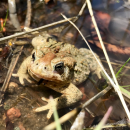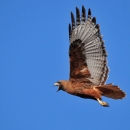About Us
Located in central Wyoming in a high plains basin near the headwaters of the “Platte–Kansas Rivers” ecosystem, the Pathfinder National Wildlife Refuge lies approximately 47 miles southwest of the city of Casper. Pathfinder Dam construction was completed in 1909, creating the first reservoir on the North Platte River. At the same time, the Pathfinder Wildlife Refuge (later renamed “Pathfinder National Wildlife Refuge”) was established as an overlay refuge on Bureau of Reclamation lands on the reservoir. This large body of water was very attractive to waterbirds, and where the refuge once offered a unique environment in this semiarid region of Wyoming, the reservoir on which it is situated is now part of a larger system of reservoirs including Alcova to the north and Seminoe to the south. Major habitat types of the Pathfinder National Wildlife Refuge include open water wetlands, sagebrush sagebrush
The western United States’ sagebrush country encompasses over 175 million acres of public and private lands. The sagebrush landscape provides many benefits to our rural economies and communities, and it serves as crucial habitat for a diversity of wildlife, including the iconic greater sage-grouse and over 350 other species.
Learn more about sagebrush uplands, and alkali flats. Average precipitation for the area is 10" annually, with summer highs near 100 and winter lows around -40 degrees Fahrenheit. High winds often create ground blizzard conditions in the winter with drifted snow.
Our Mission
The mission of the National Wildlife Refuge System is to administer a national network of lands and waters for the conservation, management and, where appropriate, restoration of the fish, wildlife and plant resources and their habitats within the United States for the benefit of present and future generations of Americans.
Our History
The origins of present-day Pathfinder National Wildlife Refuge can be traced to June 17, 1902, when Congress authorized the Bureau of Reclamation (BOR) to build the Pathfinder Dam and Reservoir in central Wyoming. Pathfinder Dam was one of the first major dams the US BOR constructed. When dam construction was completed in 1909, the refuge was established on the reservoir as an overlay refuge on Reclamation lands. Wildlife management must be compatible with those uses for which Reclamation acquired the land. Below is a summary of the legislation that has shaped the refuge over the years:
- EO 1032 (February 25, 1909)—established Pathfinder Wildlife Refuge on the Pathfinder Reservoir site “as a preserve and breeding ground for native birds.”
- EO 3725 (August 18, 1922)—revoked that part of EO 1032 reserving the Pathfinder Reservoir site for use “as a preserve and breeding ground for native birds.”
- EO 4860 (April 19, 1928)—reestablished the area created by EO 1032 “as a preserve and breeding ground for native birds.”
- EO 7425 (August 1, 1936)—established the present refuge and designated it “as a refuge and breeding ground for birds and other wildlife.”
- EO 8296 (November 30, 1939)—changed the refuge name from “Pathfinder Wildlife Refuge” to “Pathfinder National Wildlife Refuge.” Reclamation administers lands within the Pathfinder Reservoir boundary for North Platte Project purposes including flood control, irrigation, and hydroelectric power generation. A memorandum of understanding (MOU) specifies the management responsibilities of the Bureau of Sport Fisheries and Wildlife (BSFW), the predecessor of today's US Fish and Wildlife Service, while preserving the autonomy of Reclamation to manage Pathfinder Dam and Reservoir.
Other Facilities in this Complex
Pathfinder National Wildlife Refuge is managed as part of the Central Sage Steppe Conservation Complex. A Conservation Complex is a group of two or more refuges, wildlife management areas, wetland management districts, or conservation areas that are primarily managed from a central office location. Refuges are grouped into a complex because they occur in a similar region, such as a watershed or specific habitat type, and have a related purpose and management needs. Typically, a project leader oversees the management of the refuges within the complex and refuge managers are responsible for operations at specific refuges. Support staff: administrative, law enforcement, refuge manager, biological, fire, visitor services, and maintenance, are centrally located and help with all refuges within the complex.
Other refuges in the Central Sage Steppe Conservation Complex include: Arapaho National Wildlife Refuge (Walden, Colorado); Bamforth National Wildlife Refuge, Hutton Lake National Wildlife Refuge, Mortenson Lake National Wildlife Refuge, and the Wyoming Toad Conservation Area (Laramie, Wyoming); as well as Seedskadee National Wildlife Refuge (Green River, Wyoming), Cokeville Meadows National Wildlife Refuge (Cokeville, Wyoming), and Wyoming's portion of the Bear River Watershed Conservation Area. Administrative headquarters for Arapaho, Pathfinder, and the Laramie Plains refuges is located at Arapaho National Wildlife Refuge, in Walden, Colorado phone number 970-732-8202, while administrative headquarters for the southwestern Wyoming refuges is located at Seedskadee National Wildlife Refuge, 37 miles north of Green River on Hwy 372 - 246 Seedskadee Road, PO Box 700, Green River, WY 82935; phone number 307-875-2187.






